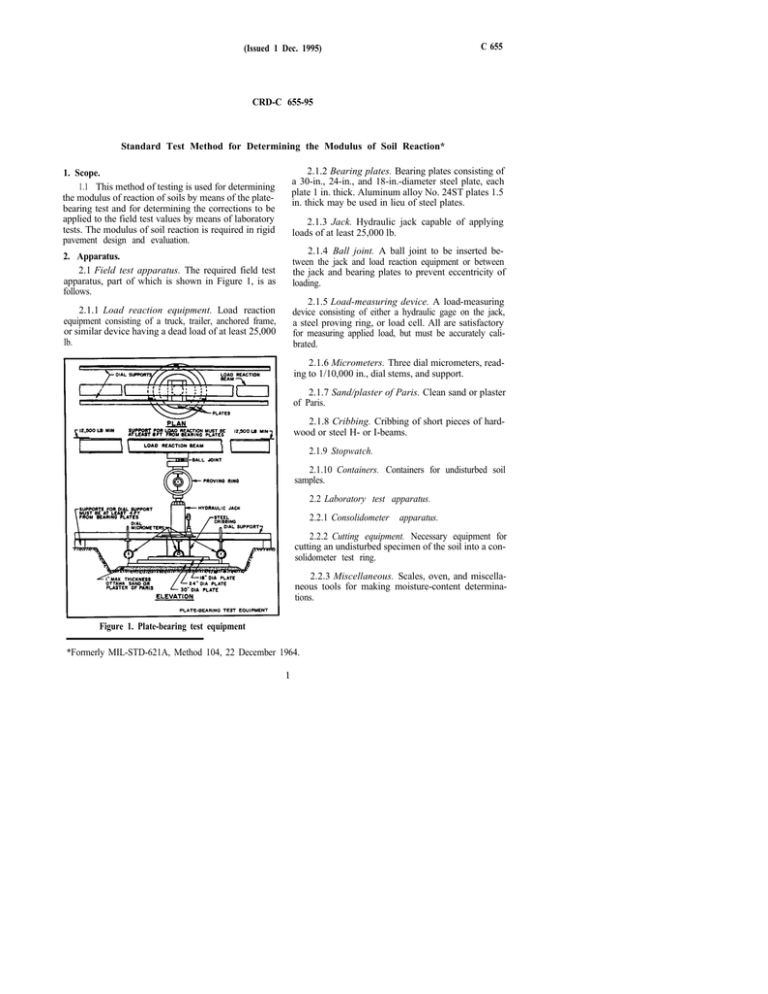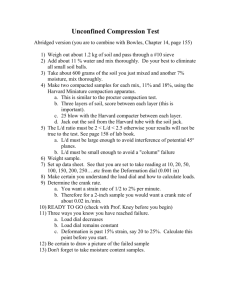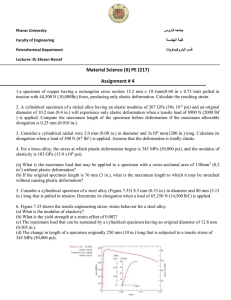C 655 (Issued 1 Dec. 1995) CRD-C 655-95
advertisement

C 655 (Issued 1 Dec. 1995) CRD-C 655-95 Standard Test Method for Determining the Modulus of Soil Reaction* 1. Scope. 1.1 This method of testing is used for determining the modulus of reaction of soils by means of the platebearing test and for determining the corrections to be applied to the field test values by means of laboratory tests. The modulus of soil reaction is required in rigid pavement design and evaluation. 2. Apparatus. 2.1 Field test apparatus. The required field test apparatus, part of which is shown in Figure 1, is as follows. 2.1.1 Load reaction equipment. Load reaction equipment consisting of a truck, trailer, anchored frame, or similar device having a dead load of at least 25,000 lb. 2.1.2 Bearing plates. Bearing plates consisting of a 30-in., 24-in., and 18-in.-diameter steel plate, each plate 1 in. thick. Aluminum alloy No. 24ST plates 1.5 in. thick may be used in lieu of steel plates. 2.1.3 Jack. Hydraulic jack capable of applying loads of at least 25,000 lb. 2.1.4 Ball joint. A ball joint to be inserted between the jack and load reaction equipment or between the jack and bearing plates to prevent eccentricity of loading. 2.1.5 Load-measuring device. A load-measuring device consisting of either a hydraulic gage on the jack, a steel proving ring, or load cell. All are satisfactory for measuring applied load, but must be accurately calibrated. 2.1.6 Micrometers. Three dial micrometers, reading to 1/10,000 in., dial stems, and support. 2.1.7 Sand/plaster of Paris. Clean sand or plaster of Paris. 2.1.8 Cribbing. Cribbing of short pieces of hardwood or steel H- or I-beams. 2.1.9 Stopwatch. 2.1.10 Containers. Containers for undisturbed soil samples. 2.2 Laboratory test apparatus. 2.2.1 Consolidometer apparatus. 2.2.2 Cutting equipment. Necessary equipment for cutting an undisturbed specimen of the soil into a consolidometer test ring. 2.2.3 Miscellaneous. Scales, oven, and miscellaneous tools for making moisture-content determinations. Figure 1. Plate-bearing test equipment *Formerly MIL-STD-621A, Method 104, 22 December 1964. C 655 (Issued 1 Dec. 1995) index > 0) proceed as follows: without releasing the seating load, apply two load increments of 3,535 lb (5 psi) each with each load increment being held until the rate of deformation is less than 0.0001 in./min. Read all three dial micrometers at the end of each load increment. Following the completion of the 7,070-lb (10 psi) load increment, determine the average deflection by averaging the total movement between the “zero” and 10-psi increment for each dial. Then compute a value of k'u, (uncorrected modulus of soil reaction) using the following formula: 3. Field Test Procedure. 3.1 Step and loading. The test setup and loading procedure are as follows. 3.1.1 Preparation of test area. Strip an area of the soil to be tested to the proposed elevation of the subgrade surface. The stripped area should be at least twice the diameter of the plates to eliminate surcharge or confining effects. If the subgrade is to be composed to fill material, construct a test embankment at least 30 in. in height using the proposed fill material compacted to the moisture content and density that will be required during construction. Clear the area to be tested of any loose materials and make it level. Extreme care should be taken not to disturb the soil in the test area, especially in granular material. Apply and level a thin layer of clean sand or plaster of Paris, not to exceed 1 in. in thickness, on the test area. k 'u = 10 psi average deflection If the value of k'u is less than 200, the test is considered complete and the load may be released. Should the value of k'u be 200 or greater, apply additional load increments of 3,535 lb (5 psi) until a total load of 21,210 lb (30 psi) is reached, allowing each load increment to remain until the rate of deformation is less than 0.0001 in. per minute. Read all three dial micrometers at the completion of each load increment. For non-cohesive soils (PI = 0), after the seating load deformation has practically ceased and the zero dial readings taken, proceed as follows: without releasing the seating load, apply load increments of 3,535 lb (5 psi) each until a total load of 21,210 lb (30 psi) is reached, allowing each load increment to remain until the rate of deformation is less than 0.0001 in./min. Read all three dial micrometers at the completion of each load increment. 3.1.4 Soil sampling. An undisturbed sample of the foundation material must be obtained for laboratory testing to determine the saturation correction to apply to the field test value. The undisturbed sample must be large enough to obtain two consolidometer specimens side by side (i.e., at the same elevation). Take the sample in a container suitable for sealing to preserve the moisture content until the laboratory correction tests can be performed. When the plate-bearing test is performed directly on cohesive subgrade material, obtain the undisturbed specimen from the foundation at the same elevation at which the test is performed, but alongside rather than under the plates. When the test is performed on a granular base course material which is underlaid by a cohesive material, and when the base course is less than 75 in. in thickness, take the undisturbed sample from the cohesive material at the bottom of the base course. 3.1.2 Test apparatus setup. Seat the 30-in-diameter bearing plate on the sand or plaster of Paris. Turning or working the plate back and forth will help to provide uniform seating of the plate. Center the 24-in.and 18-in.-diameter plates on the 30-in.-diameter plate, and center the hydraulic jack on the 18-in.-diameter plate. If cribbing is needed, crib between the top plate and the jack. A steel proving ring, if used to measure load, should be placed on top of the jack, and the ball joint should be used between the proving ring and load reaction device. The load reaction device must be long enough so that its supports will be at least 8 ft from the bearing plate. A steel beam between two loaded trucks provides a good load reaction device. Three dial micrometers shall be used to measure deformation of the soil under load. Place these micrometers so that the dial stems rest on the bottom 30-in.-diameter plate not more than 0.25 in. from the outer edge, spaced 120 degrees apart. Fasten the micrometers to a frame whose supports are at least 4 ft from the edge of the 30-in.-diameter plate. A typical apparatus setup is shown in Figure 1. 3.1.3 Loading procedure. Seat the loading system and bearing plate by applying a load of 707 lb (1 psi) when the thickness of the pavement will be less than 15 in., or a load of 1,414 lb (2 psi) when the design thickness of the pavement is 15 in. or more. Allow the seating load to remain in place until practically complete deformation has taken place. Then take a reading on all three dial micrometers, which will be used as the “zero” reading. The seating load is also considered to be the “zero” load. Cyclic loading under the seating load may be used to assure good seating of the apparatus and bearing plate. For cohesive soils (Plasticity 3.2 Load-deformation curve. To plot a load-deformation curve, the unit load (psi) on the plate is plot2 C 655 (Issued 1 Dec. 1995) ted versus the average deflection for each load increment. The average deflection is the average of the three dial readings between the “zero” and the end of each load increment. If the load-deformation relation plots as a straight line passing through the origin, no correction is necessary. However, if the load-deformation relation results in a curve or a straight line not passing through the origin, the curve is corrected as shown in Figure 2. Generally, the load-deformation curve will approximate a straight line between the unit loads of 10 and 30 psi. The correction consists of drawing a straight line, parallel to the straight-line portion of the plotted curve, through the origin. When correcting the load-deformation curve, good engineering judgment will be required. If the curve is nonlinear throughout its length, the straight-line correction will be based on the average slope of the curve through at least three points in the region of the curve having the least curvature. 3.3 Uncorrected modulus. An uncorrected modulus of soil reaction, k'U, is computed from the field test data using the formula: k 'u = 10 psi Figure 2. Correction of load deformation curve average deflection The average deflection is read from the corrected curve at a load of 10 psi. The value of k'U computed from the above formula must then be corrected for bending of the bearing plates and saturation of the soil as outlined in the following paragraphs. 3.3.1 Correction for bending of the plate. There is a certain amount of bending in the bearing plate, even when a nest of plates is used. The bending results in a greater deflection at the center of the plate than at the rim where the deflections are measured. Since the modulus of soil reaction is actually a measurement of volume displacement under load, the lower deflections measured at the rim result in a k'u value higher than actually exists. The amount of plate bending is related only to the strength of the soil being tested. Hence, for any one k'U value, the correction to be made is always the same. This correction has been determined by test and is shown by the curve in Figure 3. The correction of k'U is made by entering Figure 3 with the computed value of k'U on the ordinate and projecting horizontally to the intersection of the plotted curve. The corrected value for the modulus of soil reaction, ku, is then determined by projecting vertically to the abscissa of the plot and reading the value. Figure 3. Chart for correction of k'u for bending of the plate 3 C 655 (Issued 1 Dec. 1995) types, the specimen may swell under the seating load as it becomes saturated. Swelling of the material will result in extrusion of material above the top of the consolidometer ring, so that when the 10-psi load is applied, the material may squeeze out over the ring rather than consolidate, which will lead to erroneous results. To prevent this, when dealing with a swelling-type soil or one that is suspected of being a swelling-type soil, the consolidometer ring will not be completely filled with soil. This can be accomplished by trimming the top of the specimen a sufficient amount, generally 0.06 in., to allow for the swelling. When the specimen for saturation is trimmed to allow for swelling, the specimen to be tested at the in-situ moisture content will also be trimmed an equal amount so that the heights of the specimens will be equal at the beginning of the test. 3.3.2 Correction for saturation of the soil. The design of pavement is generally based upon the modulus of soil reaction when the soil is saturated. It is not feasible to saturate the soil in the field prior to the field test and seldom will the soil be in a saturated condition in its natural state. Therefore, the field test value must be corrected to reflect the value that will be obtained when the soil becomes saturated. Cohesionless soils are insensitive to saturation, and when the field test is performed on this type soil, the correction for saturation is not necessary. The most applicable method for correcting for saturation is through an adaption of the consolidation test. The correction test will be made on undisturbed specimens of the soil from the location of the field test. For the case where a field test is performed on the surface of a cohesionless base-course material, but which is underlain by a cohesive soil, the saturation correction will be determined by tests on the underlying cohesive material. 3.3.2.2 Corrected modulus of soil reaction. The correction for saturation will be applied in proportion to the deformation of the two specimens under a unit load of 10 psi as follows: 3.3.2.1 Tests procedure. The saturation correction factor is the ratio of the deformation of the consolidation specimen at the natural moisture content to the deformation in a saturated specimen under a 10-psi loading. Two specimens of the undisturbed material are placed in a consolidometer. One specimen will be tested at the in-situ moisture content, and the other specimen will be saturated after the seating load has been applied. Each specimen is then subjected to the same seating load (1 or 2 psi) that was used for the field test (see 3.1.3). The seating load is allowed to remain on the in-situ moisture-content specimen until all deformation occurs, at which time a “zero” reading is taken on the vertical deformation dial. Without releasing the seating load, an additional 10-psi load is applied to the specimen and allowed to remain until all deformation has occurred. A final reading is then taken on the vertical deformation dial. The other specimen is allowed to soak in the consolidometer under the seating load (1 or 2 psi). After the specimen is saturated, a “zero” dial reading is obtained; then without releasing the seating load, an additional 10-psi load is applied. This load is allowed to remain on the specimen until all vertical deformation has occurred, after which a final reading on the dial is obtained. For soils of certain where k = corrected modulus of soil reaction, lb/in.3 ku = modulus of soil reaction uncorrected for saturation, lb/in.3 d = deformation of a consolidometer specimen at in-situ moisture content under a unit load of psi ds = deformation of a saturated consolidometer specimen under a unit load of 10 psi b = thickness of base course material, in. In no case will a value of d/ds greater than 1.0 be used in the above formula. This formula is applicable for the computation of the corrected k value, whether there is a granular base course or not. However, if the base course is 75 in. or more in thickness, a saturation correction for the cohesive subgrade material will not be made. 4





